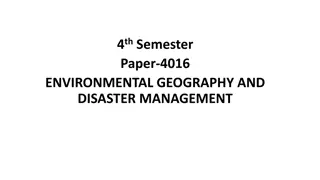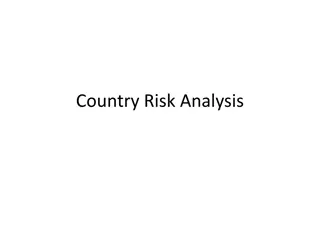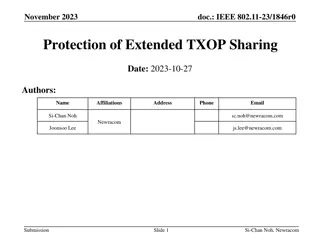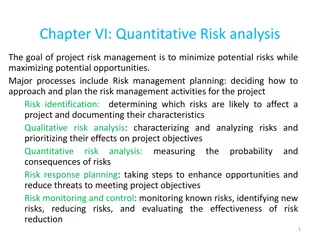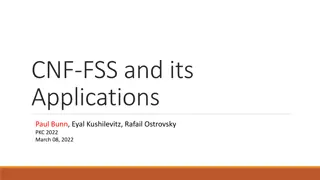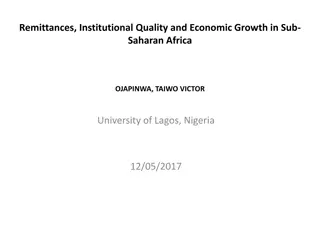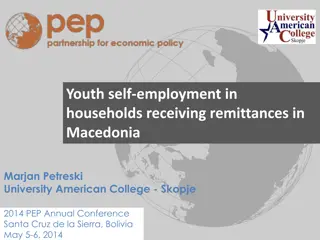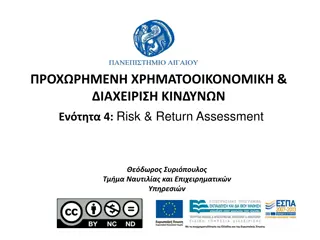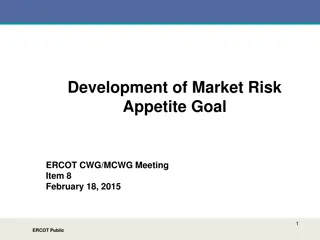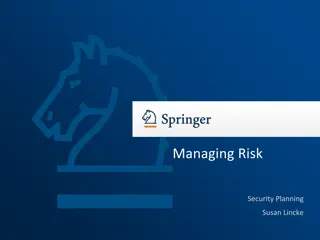Impact of Remittances on International Risk Sharing
Higher remittances in Emerging Market/Developing Economies (EMDEs) between 1990-2018 positively impact risk sharing between consumption and income growth, unlike other types of capital flows. Remittances contribute significantly to enhancing risk-sharing effects, offering about 15% of risk sharing in EMDEs. Factors affecting risk-sharing include perfect capital mobility, asset market completeness, and tradable output. Remittances are less susceptible to financial distortions compared to private capital flows.
Download Presentation

Please find below an Image/Link to download the presentation.
The content on the website is provided AS IS for your information and personal use only. It may not be sold, licensed, or shared on other websites without obtaining consent from the author.If you encounter any issues during the download, it is possible that the publisher has removed the file from their server.
You are allowed to download the files provided on this website for personal or commercial use, subject to the condition that they are used lawfully. All files are the property of their respective owners.
The content on the website is provided AS IS for your information and personal use only. It may not be sold, licensed, or shared on other websites without obtaining consent from the author.
E N D
Presentation Transcript
Comments on What Types of Capital Flows Improve International Risk Sharing? Remittances! By Ergys Islamaj and M. Ayhan Kose Menzie D. Chinn University of Wisconsin, Madison & NBER Conference on Financial Globalization and De-Globalization: Perspectives and Prospects City Univ. of HK, USC, Osnabruck University May 3-4, 2021
Main Findings For a sample encompassing 79 Emerging Market/Developing Economies (EMDE s), 1990- 2018 Higher remittances are associated with better risk sharing (as measured by between consumption and income growth) No such comparable finding is found for other types of capital flows
Approach Regress idiosyncratic consumption growth on idiosyncratic global growth Under maintained hypothesis of perfect risk sharing, =0
Approach Regress idiosyncratic consumption growth on idiosyncratic global growth Under maintained hypothesis of perfect risk sharing, =0 Enhanced risk sharing effect if interactive term is negative
Remittances and Risk Sharing Using the risk sharing estimate: Implies: about 15 percent of the achieved risk sharing in EMDEs can be attributed to remittances.
A Joint Hypothesis Perfect capital mobility across countries and zero transaction costs Second, asset markets must be complete, so that all idiosyncratic consumption risks are insurable. Third, in order for international trade in assets that bear claims on a country's domestic output to be feasible, output must be tradable. So once one rejects composite null, point estimate is not necessarily reflective of degree of risk sharing
Maybe Not Such a Puzzle (with Hindsight) Private financial capital flows uphill, due to Institutional underdevelopment and possible expropriation Private flows procyclical due to asymmetric information causing herding, runs Remittances are not as susceptible to these distortions (next slide) - intra-household? - harder to expropriate selectively?
Conclusion Clearly motivated, clearly organized One of the few papers addressing remittances and risk sharing at the cross-country macro level Robust findings on remittances contrast nicely with the near zero impact of capital flows Establishes a new stylized fact Looking forward - A panel analysis looking at how remittances comove (or don t) with financial capital flows might be illuminating



